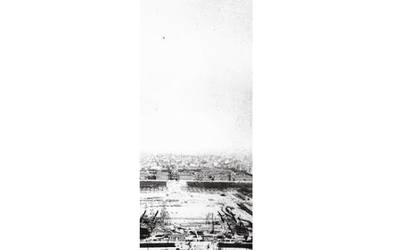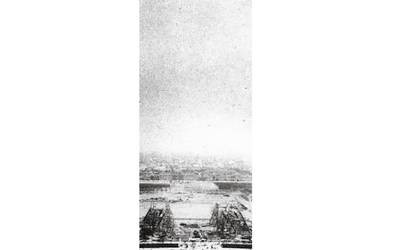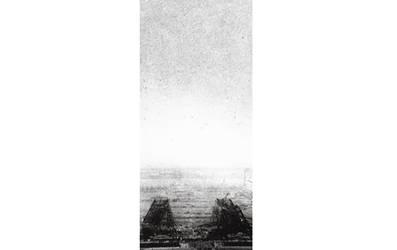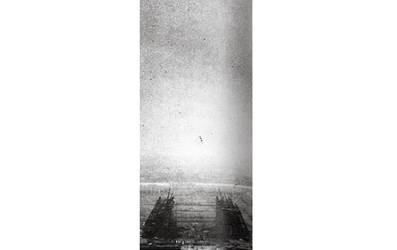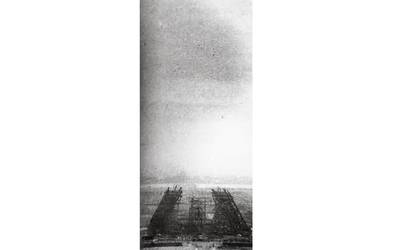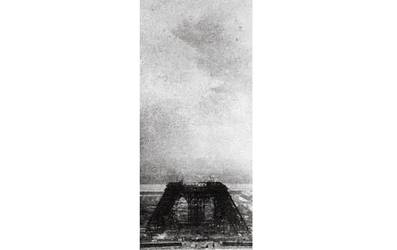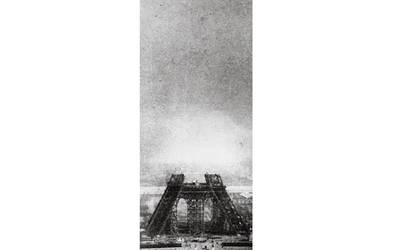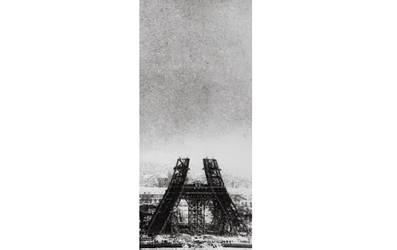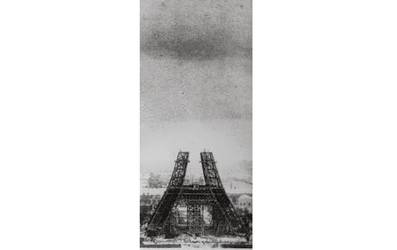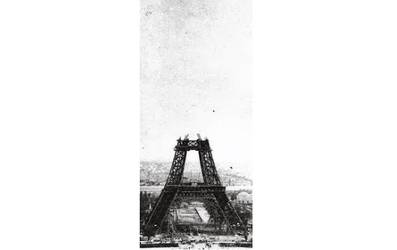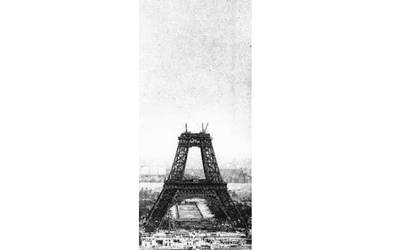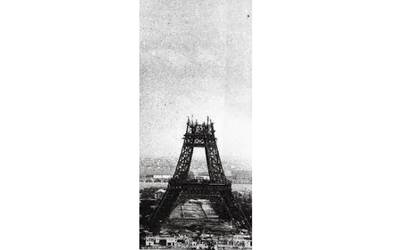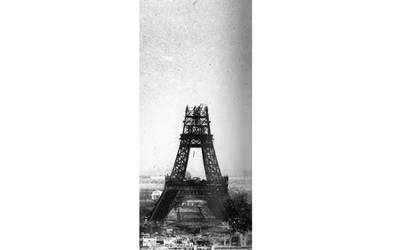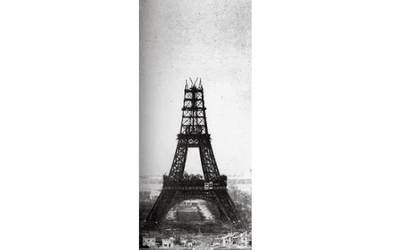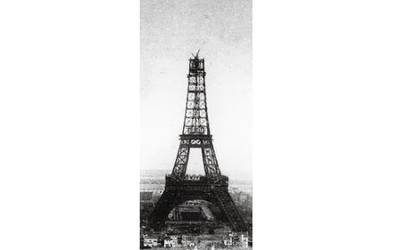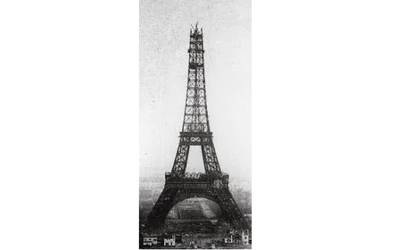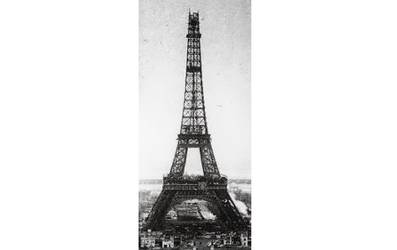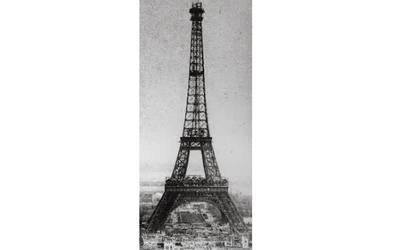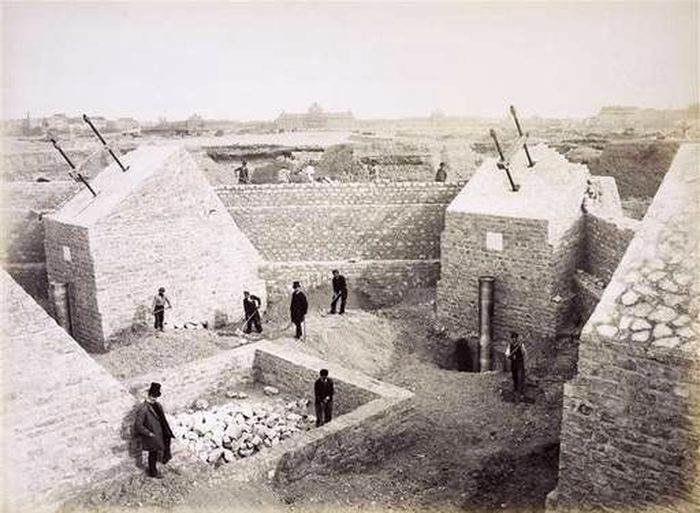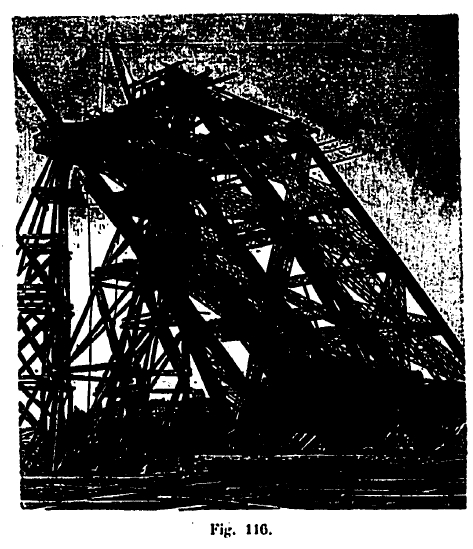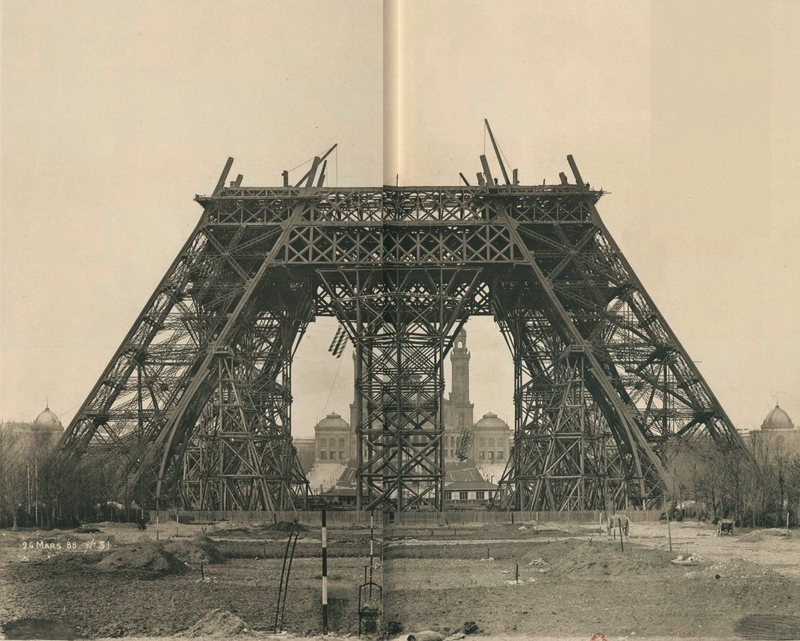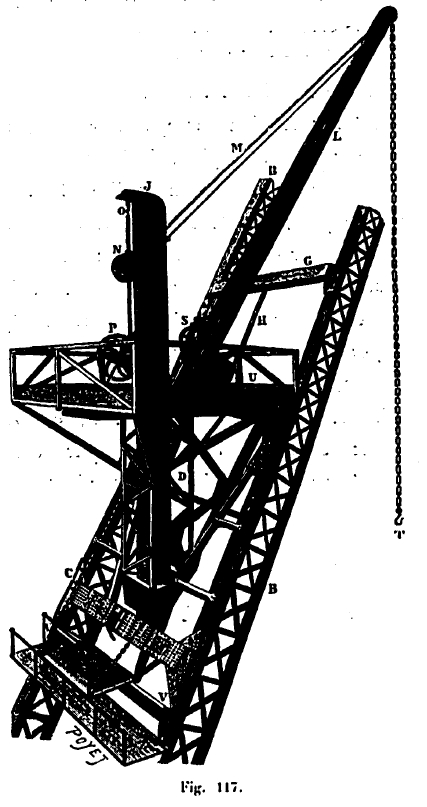To worry about how the Eiffel Tower was built requires first to worry about concepts in metal construction. The best thing is to be guided by Gustave Eiffel himself, who gives in his book "The tower of 300m" some notions that he acquired on this subject. Do not panic, it's very simple to understand. His texts have been modified to better fit the literary style that has evolved since the last century, and to simplify certain elements, too complex to be discussed here.
If you wish, you can read the history of the tower before its construction, it is explained on the page History of the Eiffel Tower, very detailed. Otherwise, here is a summary.
Before construction ...
Following the establishment of a technological challenge that became possible with the advent of the Industrial Revolution, engineers from all countries had sought since the mid-nineteenth century to create a tower of 1000 feet high (about 300 meters). such a challenge could not be achieved with the usual technologies, stone and cement not resisting the pressure of such a monument. It is the use of metal that will make this project possible. Various projects appeared, but it was the entrepreneur Gustave Eiffel who, on the proposal of plans of his heads of the design office and head of the office of methods (Mr Koechlin and Nouguier), would make the first realistic project. A competition for the construction of a 300m tower in Paris was launched, and it was Eiffel who won it. The idea was to build this tower on the Champ de Mars for the Universal Exhibition of 1889. The plans were drawn by the many staff members and an architect, Mr Sauvestre, who entered the project. But Eiffel, feeling the interest of a tower so high, redeemed the rights of his colleagues, and that is why the Eiffel Tower is called today, when it was designed by Nouguier and Koechlin.
Let us now see how the Eiffel Tower was built.
1. Preliminary work at the workshops
2. Organization of the worksite, workers
1. Preliminary work at the workshops
The principle of construction adopted by Eiffel was simple. In his Levallois-Perret workshops, the metal parts had to be constructed according to the precise plans of the designers of the design office, from the biggest beam to the smallest rivet. These parts were assembled together with temporary rivets to form elements that met a simple criterion: Make less than 3 tons. Then it was the assemblers who came into play, they collected these pieces on the site and assembled them definitively. At the Eiffel workshops there were more than a hundred workers to work. There were a few all the professions of the metallurgy because there were many different jobs to be carried out. In total during the period of manufacture of the pieces of the Eiffel Tower it is more than 18 000 pieces that left the workshops.
Unlike Eiffel's other works of art, the parts of the tower could not be drawn at scale 1, as was the case most of the time. Here, the sketches were scaled because the pieces were too large to be drawn in life size. It was therefore necessary to calculate the position of the assembly holes with great precision, since everything was theoretical, and these holes had to be drilled to the nearest tenth of a millimeter.
In order to verify the correct position of the holes, pincers, sorts of weakly conical rods were used which were forced into the holes. You could see immediately if everything was fixed. It is interesting to note that this "French" method is opposed to the English method which requires that a large number of approximate assemblies be drilled and that the bulk of the adjustment work is done on the site . It is another method, easier in the workshops but more complex to implement during the final assembly, and a metal tower the size of the Eiffel Tower would necessarily have been complex to achieve as well.
In the radius of the figures, let us mention the astronomical quantity of drawings which have been made: 1,700 general drawings and 3,629 drawings for execution. The surface area of these 5,300 designs exceeds 4,000 m2! To draw all that, it took no less than 30 designers who worked for 18 months.
More details about: Work at the workshop.
See the Maps of the Eiffel Tower.
2. Organization of the worksite, workers
Photos courtesy of L'Illustration.com.
A construction site the size of the Eiffel Tower has inevitably required an enormous preparation work, but also a very rigorous organization of the site itself, and this at all levels and stages of construction. It is of course the construction itself which was the most interesting period of this adventure.
It was even one of the most virulent criticisms made at the Eiffel Tower, before its construction: The impossibility of organizing a construction site of this size without lamenting a very large number of dead, According to them vertigo had to be such that no one could resist it: the placing of the pieces under the efforts of the wind reigning at these heights must present insurmountable difficulties, etc. And yet none of this has happened and it is in time and time, after following the planning perfectly determined in advance that the tower was delivered. There were no deaths or accidents of any kind, whether from machinery or scaffolding, from falling tools, parts or workers. There was only one worker fall; it was that of a young boy, who, after the bell rang for the closing of the site, rushed imprudently on one of the iron pieces on which the passage was formally forbidden, and which fell from the height of the beams of the first floor . This information comes from Gustave Eiffel himself and he specifies that this fall can not be charged to the work, since it had just ended.
Falling tools were all the more dangerous as the workers worked one below the other. Thus, in order to protect themselves from the serious consequences which they might have had, all the platforms of work were formed by jointed planks, and they were provided with prominent ledges.
The falls of heavy pieces would have had, if they had occurred, disastrous effects; so they had done everything possible to avoid them to the maximum. It went through a careful study of the craft, and constant monitoring of the men. As for the workers themselves, they were installed as much as possible on solid platforms, provided with guardrails, but this was not always the case, alas.
This result, such an assembly carried out without any serious accident, was due to the care with which the site was organized, and mainly to that brought to the choice of the men constituting the teams who shared the work. These teams, completely independent and autonomous, each had their own chiefs responsible for each of them, and were only linked by the management of the site supervisor. A great emulation reigned between them. The choice of the men was such that their retention in the teams only took place after a training period to ensure that they had the skills required by the work, that they possessed a similar character and way of doing things to those of their comrades, and that, as far as principals were concerned, they were agile and prudent.
The composition of the uprights, roughly similar from bottom to top, had made it possible to specialize the men in each team, always charging them with the same operations. The mooring of the pieces, in particular, was done by a moorer, always the same, under the supervision of the head of the pile.
Each of these pile-heads was never, under any pretext, to leave the mounting scaffolding, and had to make sure by himself, before the men settled there, that the flying or other scaffolds were firmly established. It is almost superfluous to add that there was an absolute prohibition on bringing alcohol to the site, and that all drunken men were immediately dismissed or quarreled with their comrades during work. It must be said that the consumption of alcohol at the end of the 19th century was more frequent than today and taking what would be considered a large quantity of wine at noon was frequent. On the construction site, it was simply - almost forbidden, as the exception explained in the paragraph below, "The canteen".
The assembly lasted twenty-one months, during which the work never stopped in spite of two winters, the rigor of which was hardly felt at the great height at which the site was situated. All the workers, proud of the work to which they were collaborating, admirably led by their head of department, M. Compagnon, and by the chief of the shipyard, M. Milon, both of whom set an example, most dangerous places, all without exception have shown energy and courage above all praise.
Planning of construction
It can be estimated that the construction of the Eiffel Tower was made in good conditions of delays, with a schedule that was held and which therefore did not know any unknowns. Work began on the foundations of Pile 2 on January 28, 1887. The digging and construction of the pedestals lasted until July 1, and assembly began. It lasted from July 1, 1887 to April 15, 1889, twenty-one and a half months, and even nowadays it would be difficult to do so quickly. good, nowadays, the security conditions would be much superior, and the constraints more difficult to respect, but still ...
The main stages of the construction were on December 7, 1887, with the junction of the 4 pillars on the 1st floor, probably the most delicate maneuver to be carried out in the entire site, September 1888, when the tower passed the tallest building of Paris, and March 31, 1889, with the tricolor flag crashing at the top of the tower, marking the end of its construction.
On the page below the schedule is detailed, it is relatively interesting.
See the Construction planning.
Staff
The construction of the tower did not pose any particular problem, the construction site, was finished before the deadline. It should be noted that the strike of the workers, as the winter of 1888 approached, demanded better working hours and a risk premium given the height at which they worked. Gustave Eiffel ceded the premium he increased, although he noted that the workers were better paid on this site than on another, but refused to index the premium on the working height, as the risk was, according to it is the same regardless of the working height.
The construction site employed a maximum of 250 people, which was already quite good, and in spite of the risks no deaths were to be deplored. The staff was divided into teams with a fairly large hierarchy, as was the case at the time. At the job site, team leader, team leader, workers, laborers, tacherons, all had a precise role and often they did only one job, one activity. For example, the riveter teams consisted of four people: a riveter, a hitter, a heap content and a driver foam. This organization was repeated indefinitely according to need, and sometimes - rarely - they received another role.
Among the most well-known roles are assemblers, in charge of assembling the metal parts, riveters, who put the rivets in place, the shields that covered the pieces, the carpenters, responsible for the elevation of the scaffolding , blacksmiths, site supervisors, etc. Below you will find more details on the organization of the teams, the number of people per post and their evolution over time.
More detail about: The staff.
3. Construction
The foundations
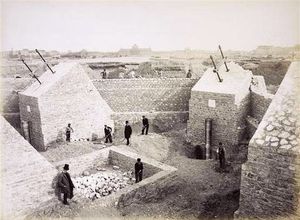
The foundations
Photos courtesy of L'Illustration.com.
The foundations marked the beginning of the work, it happened on January 28, 1887. They were made with the shovel with arms of man. The excavated material was evacuated either by steam locomotives or by horse-drawn carriages. The four foundations were launched almost at the same time and they progressed at about the same time. The deepest descends to 15m, no more. According to Eiffel's calculations, the pressure on the floor of his tower did not exceed that of a building, so the residents had nothing to fear from possible movements of land. The ground pressure calculations were made of course, they are available on the page explaining the bases.
But each pillar was different from the others. Thus the 1 and 4, those on the Seine side, had to be the subject of drilling wells because they were close to the Seine. Once the work was decided, water was infiltrated. To remedy this problem, Eiffel used a technique that had been used several times on other sites, such as compressed air foundations, using sheet metal casing buried 5 meters below the water level. The two other pillars, on the Champs-de-Mars side, had no particular problems. The foundations were heavy blocks of concrete (they are called massifs) designed to receive the load of the 4 masonry bases which themselves receive the mass of the metal structure. These buried concrete blocks served as a starting point for the crossbowmen.
The detail of the foundations, given in the link below, is very complete. He explains, for example, why the foundations are not identical, the duration of the works, how the tons of rubble were removed and what happened, and also the list of cubes extracted.
More detail of: The foundations of the Eiffel tower.
The 4 pedestals of the tower
The bases of the 4 pillars are in fact heavy massifs taken from the foundations and surrounded by walls of cut stone and concrete. Subbases were created later, they are made on the basis of a metallic, braced frame, which is laid on the concrete walls of the foundations and caught in the stone blocks. These foundations are late, ie they were built well after the assembly of the metal structure. It was not necessary to make them entrance, they did not serve as support for the pillars. This work lasted from September 23rd, 1888, to January 4th, 1889, when the bases were completed for all four piers.
It is these foundations which contain various rooms housed in the pedestals, such as the warden's room, the technical rooms of the elevators, etc.
More detail about: The pedestals of the Eiffel tower.
Construction of the pilars
The pillars were mounted on the pedestals. The whole problem was the inclination of the crossbowmen, who formed the starting-point of the pillars. Indeed, the pillars were supposed to meet at the first level at the same altitude, but a tiny deviation at the start causes an unacceptable gap at the finish. A solution was therefore needed to incline to a certain extent each pillar. Two solutions were used at the same time. First hydraulic cylinders were installed at the feet of the pedestals under each crossbow, they allowed to play on the positions of the pillars. The second solution was simpler but even more effective. On the wooden scaffolds which were used by the workers of the sand boxes were laid. The joists were placed on the caissons and they were then enough to remove the sand from the box to lower the joist. This tip made it possible to tip more or less of the pillars to be sure that they were perfectly aligned at the level of the first stage.
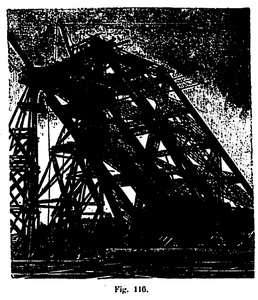
Battery lifting scaffolding
This necessitated, of course, the construction of solid wooden scaffolds, one for each pillar. As the construction progressed other scaffolding was put over the first, and so on until reaching the first floor. It should be noted that a reconstruction of the hydraulic cylinders was made in 1995, it is still visible on the first floor of the tower, in the Ferrié Pavilion.
Nor was the assembly of the parts especially simple. At first the pieces to be assembled were placed on the ground and mounted with man's arm at the right height. But very quickly it was necessary to use a crane, which itself was not sufficient. Mobile cranes were then used, fixed on the future rails of the elevators. The interest was great. These cranes themselves mounted the rails on which they were to ascend, and permitted the passage of the bracing beams and crossbowmen to the right height.
At the same time as the crane, the fitters used wooden scaffolds, one per pillar. This was necessary because Gustave Eiffel had calculated that from 28 m height the center of gravity of the pillars would be outside the square formed by the base and would therefore start to force the rivets. And considering the weight of each pillar, it was necessary to use a method of support: This is where the sand boxes come in.
The next page explains in detail the methods used to build the pillars (Sandboxes, scaffolding, cranes, etc.).
More detail about: The construction of the pilars.
Construction of the floors
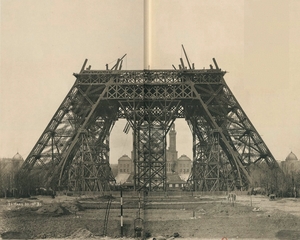
Construction of the first floor
The floors were assembled in the same way as the first floor, the height in addition. The scaffolding was replaced by a single central scaffolding, and the crane was used by increasing the parts higher and higher. The starting point was the floor of the first floor because the cables became too long to be used. A hoist was used to mount the rooms on the first floor.
From the 2nd floor the construction had to change method since the railway lifts stopped there. These were two hanging lifts that were to mount the visitors to the top of the tower, but it was not possible to use the elevator cage for the crane. Moreover, the tower had become a simple central pillar with an architecture of struts repeated with panels in panels, so the crane had to take an external road, which was done by the addition of a frame supported on this pillone.
The other difficulties were the installation of the floors. The floor of the 1st floor is very imposing, the beams are therefore extreme heavy. Their implementation has been of the utmost detail. The 2nd floor floor was simpler, it was smaller.
Mode detail about: The construction of the floors.
Construction of stairs and elevators
The stairs from the ground to the first floor were not raised until about November; until then, the circulation was made by a wooden staircase established along the beams of elevators. From the first floor, the spiral staircases were installed as the assembly progressed.
The assembly of the Combaluzier lifts began with the installation of the ducts containing the circuit of articulated pistons, which was made by winches moored on the pillars of the Tower. The only difficulty it presented was the placement of the cylinders with their divers, whose weight was 12 tons. They were lowered into the pit with the 8-tonne rope hoists which had been used to haul the cranes in the upper part. For the fitting of the cabins, which could not pass through the intervals of the trusses of the uprights, a median strut had to be derived: each cabin was rolled on an inclined plane and connected to the circuit, passing over the base (19 January at 2 June 1889. Commissioned on 26 May and 2 June).
The installation of the Otis lifts began on January 5, 1889, with the installation of the large support beam for the cylinders and the trolley. The beams of the counterweight and the mechanism were then assembled: the latter was installed keeping the cabin with its safety device on the ground, and at the top of its course the counterweight and the trolley of the hoist. When the cylinder was connected to the hoist by means of the piston rods, the cables were laid. After a certain period of testing, the launching, for the public, took place on June 4 by the North pillar, and on June 19 by the South pillar.
The installation of the Édoux lift began on 20 February and was completed on 2 June. All the parts of this apparatus were brought to work on the second floor, and on the intermediate level by our hoists, where they were picked up by the fitters of the house Édoux, using hoists.
The sections of sheet-metal cylinders, held at their head by a collar bearing on the platform, were gradually lowered to their respective positions. As for the divers, whose total weight would have required a relatively large lifting device, they were immersed.
The elevator was brought into service on 13 June.
Installation of restaurants
The restaurants built on the first platform were assembled from the month of January 1889. We began by those of the faces Paris and Grenelle; they continued by that of Trocadero; then, on the 15th of April, after the demolition of the freight elevators, one could go to the restaurant on the side of the Military School, where he occupied the site. After this necessary demolition, a considerable quantity of materials had yet to be assembled for the fitting out of the storeys, and to be evacuated from the floors, scaffolds, materials and materials of every kind. Also, a series of goats had to be set up on the first floor, night shifts should be set up, and work should be carried on with an excitement aroused by the proximity of the final delay.
If you are surprised by the number of restaurants on the first floor of the Eiffel Tower at the end of the 19th century, it was because at this time this floor was made of a quadrangular gallery, faces were the facades of bars and restaurants, which occupied a large area. There was a French restaurant, a Russian, an Anglo-American bar, a theater, and so on.
4. Mounting techniques
Installation of rivets
It may be futile to think that the installation of rivets is of great importance when talking about the Eiffel Tower. And yet, with 1,050,810 rivets exactly, it is worth the interest. The detail shows the amount installed per period, but let us interest ourselves for a moment on the way we put a rivet at the time. It took 4 people, a team used to work together. The driver has an oven in which he plunges a rivet that heats quickly "to red". The riveter installs it in the hole consolidating two pieces. The third worker holds the head of the rivet while the batter, the last to intervene, strikes with a blow the point of the rivet which, heated, crashes against the other face of the pieces to be assembled. The rivets so fixed are for eternity. Note that this is how we built for a long time. Reports from the early 20th century show workers do the same on the towers of the Empire state building, four decades later.
The detail below shows additional information about the riveurs of the Eiffel Tower.
More details about: Installation of rivets.
Mounting Cranes
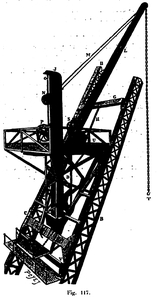
Crane diagram
Mounting cranes were the most useful tools. Using the paths of the future elevators, they were used to easily mount the beams, joists and spacers at the desired height on the platforms of the work scaffolds. Initially there was only one, it was in service on stack N ° 3. Then three others were installed, it became necessary.
If the document below (click on the link) really details the installation and operation of these cranes, it is worth dwelling on how to climb them up one level. It was relatively complex, it had to lock the crane, mount structural elements, raise the assembly, lock again, and that to win 50cm. Now every climb was spoken in meters. Sometimes it would take several days for a crane to be able to use a lifting crane. Moreover, the weight of each vacuum crane was 15 tons; so the connection of the chassis to the elevator beams required no less than 170 20 mm steel bolts. Hence the complexity of the maneuver!
More detail about: cranes.
Mounting and Rigging Scaffolding
The assemblers' floor consisted of 25 x 25 fir sills, joined by a bastaing deck; it relied on the spacers and the diagonal existing on each floor.
As the joint of the sections was generally in the middle of the panel, a small special scaffolding was necessary to reach it. This one had very small dimensions, 2.00 m of side, approximately; it was formed by four planks and light planks, and carried by bolts passed in holes of rivets of the section already in place, which had been blown up before the assembly. These bolts were placed from the inside of the stretch, which was accessed through the manholes, and into which they hoisted themselves on the internal gussets. The assembly of the sections on these small flying scaffolds without guardrails was one of the operations that required the most attention from the assemblers.
Above the second stage, this device was modified, and small sapines were placed on each side, which went from one section to the other and which were attached by lifting chains.
The platform of the riveters was constituted by a square framing outwardly the crossbowmen. The sides of this square were formed by two courses of pine trees of 20x20 distant 1.10 m on the outer sides of the upright and 1.60 m on the inside faces, due to the inclination; these two spruce courts were connected by cross-beams to the spacing of 1 m and covered by boards of 0.23 m in width and 25 mm in thickness. On these pieces of periphery were supported, in the interior of the pillar, other fir-trees, with cross-pieces and bastaings. For the work of the riveters, this platform formed a vast floor, surrounded by solid guardrails. Since it needed to be hoisted at variable heights for the rivet either of the junctions of the panel, or of the intermediate joints of the sections, it was suspended from the upper strut by ropes, which had been made of wire to avoid the risk of fire. The lifting was done by the cranes.
See also:






